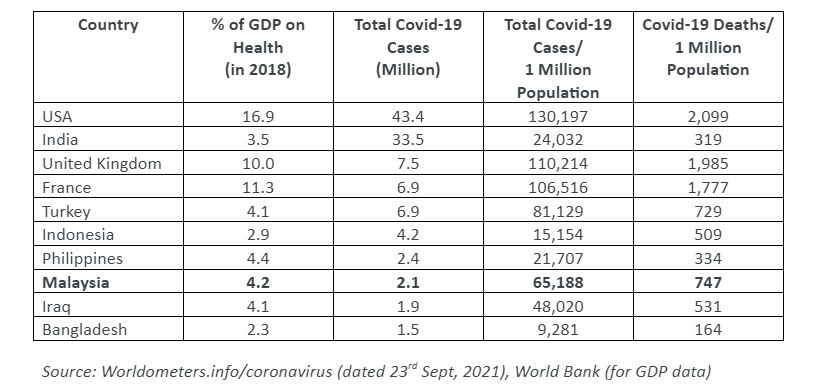This question has been repeatedly asked in parliament recently and by many people in the world, including Malaysia, grappling to manage the Covid-19 pandemic and the economy.
With cases of Covid-19 surpassing two million and total deaths at more than 24,000 as of September 21, 2021, the question is whether the amount that Malaysia spends on health care is sufficient to overcome this pandemic. Have we been under-investing in health in the past that we are now having to ask this pertinent question?
According to the finance minister in a written reply in parliament on September 20, overall expenditure on health has been increased from 4.2 per cent of GDP in 2016 to 4.7 per cent in 2020. It is expected to hit 5 per cent of GDP or RM72.7 billion in 2021.
Some have argued that 5 per cent of GDP is a recommendation by the World Health Organization (WHO). Others said it should be 6 or even 7 per cent, as stated by the Ipoh Barat MP.
According to William Savedoff in a publication in 2003, WHO has not recommended any amount of GDP (percentage of GDP) that a country should spend for health.
According to the latest available Malaysia National Health Accounts (MNHA) from 2019, Malaysia has been spending over 4 per cent of its GDP on health care since 2012. The ratio between public and private expenditure was 52.5 per cent to 47.5 per cent in 2019.
The top three sources of expenditure are the Ministry of Health (44.9 per cent), private out-of-pocket expenditures (35 per cent), and private insurance (7.6 per cent).
In terms of providers, hospitals accounted for 55 per cent of expenditure, followed by providers of ambulatory health care (21 per cent) and general health administration and insurance (9 per cent).
Services of curative care accounted for 68 per cent of functions of health, followed by health programme administration (8 per cent) and medical goods dispensed to outpatients (8 per cent). The distribution of sources, providers and functions over the past five years have remained the same.
Many have argued that we should be spending more on health care to overcome the pandemic that we are facing now, or any future pandemics that we might face. But does the amount of health expenditure a country spends determine how well it manages the Covid-19 pandemic?

From the table above, we can see that countries like the Untied States and the Untied Kingdom that spend a large portion of their GDP on health care have not done well to manage the Covid-19 pandemic in terms of total cases and deaths per one million population, compared to less developed countries.
For Malaysia, even though we spent more on health care compared to Indonesia, Iraq and Bangladesh, we did not manage the pandemic any better than them.
Therefore, how much a country needs to spend on health is determined by many factors, including current epidemiological profile, desired level of health status, cost of other demands on social resources, and the availability of resources.
The health status of a country does not depend on the amount of expenditure on health care, but on the physical, social and economic environments and individual characteristics and behaviours.
The outcome of managing a pandemic is dependent not on how much we spend, but by other factors, as can be seen in countries that have successfully managed the pandemic well.
With the 12th. Malaysia Plan and Budget 2022 to be presented in parliament soon, we should not be too focused on the amount of allocation for health care, but how we manage the resources that will be provided for health care in the next few years for the wellbeing of the people and country.
- This is the personal opinion of the writer or publication and does not necessarily represent the views of CodeBlue.





